This article was co-authored by Harmony Corelitz. Harmony Corelitz is a Plant Specialist and the Ecommerce Manager at Crimson Horticultural Rarities, Inc, a boutiue offering rare plants, flower arragements, and handmade goods. Harmony grew up helping her parents run their family business in plant maintenance and interior plantscaping. Harmony specializes in indoor plant care and interior plant design. Prior to her workwith Crimson Horticultural Rarities, she started her pop-up plant and vintage home goods shop called Younger Child and helped her former employer, Plants and Friends, grow and expand to two locations. She holds a BA from the University of San Francisco.
There are 10 references cited in this article, which can be found at the bottom of the page.
wikiHow marks an article as reader-approved once it receives enough positive feedback. This article received 46 testimonials and 95% of readers who voted found it helpful, earning it our reader-approved status.
This article has been viewed 605,149 times.
Orchids are plants that produce beautiful and unique flowers. When you're growing orchids, it’s important to repot them now and then. However, repotting is stressful for plants, so it’s also important that you only do this when it is absolutely necessary and that you're very careful throughout the process. But a successful repotting will extend the life of your orchids, so you should do it regularly as the plants grow.
Steps
Organizing Your Transplant
-
1Pick the right time. According to plant specialist Harmony Corelitz, "Orchids need to be transplanted every year so they can have a fresh potting medium." For most orchids, spring is the ideal time for transplantation, but there are also other factors to consider. Corelitz also suggests "repotting an orchid when its roots have completely overgrown the pot, when the leaves fall off the plant, or when the roots start to look soft and brown." You should also transplant:[1]
- After the plant has bloomed and is growing new roots or leaves
- When it’s not currently flowering or forming new flowers
- If the pot breaks
- If the plant becomes infested with bugs
- If growing medium is wet and not draining properly
-
2Select a suitable pot. Pot choice for orchids is important, and this includes the size and the style. Transplanting an orchid into a pot that’s too large will force the plant to focus on root growth rather than flowering. Also, for an orchid to survive, it has to be placed in a pot with drainage holes. Plant specialist Harmony Corelitz suggests "choosing a pot that's just 1–2 in (2.5–5.1 cm) larger than the current one." She also advises "using a pot with drainage holes on the sides, so there will be good airflow and drainage."
- You can use plastic or terra cotta pots for orchids. Terra cotta pots require more frequent watering.
- Opt for a shallow pot versus a deep one to prevent water buildup.
Advertisement -
3Choose the right growing medium. Most orchids don’t grow in the ground like other plants, but instead grow on trees. Because of this, many orchids cannot grow in regular potting soil, and instead need a very loose soil that’s amended with chunks of bark and other organic matter.[2] According to plant specialist Harmony Corelitz, "sphagnum moss or a mix of bark" are good potting mediums.
- Some other popular mediums for orchids include coconut husk, perlite, fir bark, and mixtures of these.
-
4Water the orchid. Before transplanting your orchid, give it some water three days prior to help reduce the shock of transplanting. Don’t give it more water than usual, however. Instead, give it enough to moisten the growing medium it’s currently in.[3]
- Remember to fertilize your orchid once per week with a weak 20-20-20 fertilizer solution.[4]
-
5Soak the new medium. Many orchid media are dry, and soaking the medium before transplanting will help it absorb and retain more moisture. To soak the medium:[5]
- Fill the new orchid pot with as much growing medium as you'll need to repot the orchid
- Transfer the medium to a bucket that’s about twice as large as the new pot
- Fill the bucket the rest of the way with water
- Let the medium soak for one to two hours
- Strain the medium through a fine-mesh strainer
- Pour running water over the medium to remove dust
-
6Sterilize a cutting tool. Once you remove the orchid from its current pot, you'll need a sterilized knife or scissors to trim dead roots and leaves. It’s important to use a sterilized tool to prevent the spread of viruses and diseases.
- One way to sterilize your cutting tool is by holding it over an open flame until the metal glows red hot.[6]
- You can also soak the knife or scissors in a disinfectant, such as iodine or alcohol. Soak for about 20 minutes.
- Another way to sterilize your instrument is by boiling it in water for 20 minutes.
Uprooting the Orchid
-
1Remove the orchid from the pot. Place your hand over the base of the orchid so your hand covers the top of the pot. Hold the pot with your other hand, and gently turn the orchid upside down into the hand that’s cradling the plant.
- If the orchid is clinging to the pot, massage it out by gently wiggling it back and forth.
- Only cut roots or stems if you cannot gently shake the orchid loose from the pot. If you have to make any cuts, preserve as much of the root or stem as possible.[7]
-
2Rinse the roots. While still holding the plant carefully with one hand, gently pick away as much old medium as possible with your fingers. When you’ve removed the bulk of the medium, rinse the roots under warm water to remove the remainder.[8]
- Removing all the old medium will ensure that your orchid gets the most nutrients possible when you transplant it, and will make sure any bugs are destroyed.
-
3Trim dead roots and leaves. Once your orchid is clean, inspect it carefully for dead leaves, stems, roots, and pseudobulbs. Use your sterilized cutting tool to trim away any roots that are soft and brown, any leaves that are yellowing, and any pseudobulbs that are black and shrivelled.
- A pseudobulb is a feature on some orchid types. It’s a bulbous growth near the base of the plant that will have a leaf growing from it.[9]
- If you're transplanting multiple orchids at once, sterilize your cutting tool in between plants by wiping it with a disinfectant or heating it with a flame.
-
4Sprinkle cut ends with cinnamon. Cinnamon is a powerful fungicide that can help protect the orchid from infection and rot. Use ground cinnamon and sprinkle the ends of any roots, stems, pseudobulbs, or leaves that you trimmed off.[10]
- You can also use an orchid-specific fungicide.
Repotting the Orchid
-
1Place the orchid into its new pot. Gently bring your orchid to its new pot and place the roots inside. Make sure the plant sits in the new pot at the same depth as it did in the old one, or so that the lowest leaf’s base is a half-inch (1.3 cm) lower than the pot’s rim.[11] If your orchid is sitting too low, remove the plant and add a layer of medium to the bottom of the pot.
- For orchids with pseudobulbs, position the orchid so the pseudobulb is at the edge of the pot.
- For orchids growing from a single major stem, position the orchid in the center of the pot.
-
2Add fresh growing medium. Sprinkle the growing medium into the pot, and use your fingers to gently press the medium in and around the roots. Add enough medium so that it comes up to the base of the orchid.
- When you’ve added all the medium and packed it loosely around the roots, carefully tilt the pot from side to side to make sure the orchid doesn’t flop around. If it does, pack in a bit more medium.[12]
- To settle the medium in place, pick up the pot and gently tap the bottom against a flat surface a couple times.
-
3Water the plant. Spray the orchid with water for three weeks, but only after the roots begin to grow. Once the orchid is settled in its new pot, add enough water to soak the medium thoroughly. Over the next few weeks, you may have to water the orchid more frequently until the medium is able to absorb and retain more moisture.
-
4Add a stake for security. Orchids can easily become top heavy if they have a lot of flowers that bloom at once. Prevent them from slumping over by attaching the plant to a stake.
- Insert a thin bamboo stake into the center of the pot.
- Gently tie the main stem to the stake with soft string. Tie the plant at the middle and near the top.[15]
-
5Provide the orchid with more humidity and shade for a week. To reduce the plant’s stress from being repotted, move it somewhere that gets filtered sun only. Keep it out of full and direct sunlight for about a week. To provide more humidity, mist the stems, leaves, and roots twice a day for a week.[16]
- You can also cover the orchid with fleece to help provide extra humidity.
- After a week, return the orchid to its regular place. Orchids like bright, filtered sunlight—about 3–5 ft (0.91–1.52 m) from a window is ideal.[17]
Expert Q&A
Did you know you can get expert answers for this article?
Unlock expert answers by supporting wikiHow
-
QuestionHow do you reproduce an orchid?
 Maggie MoranMaggie Moran is a Professional Gardener in Pennsylvania.
Maggie MoranMaggie Moran is a Professional Gardener in Pennsylvania.
Home & Garden Specialist
-
QuestionWhat is the best potting medium for orchids?
 Maggie MoranMaggie Moran is a Professional Gardener in Pennsylvania.
Maggie MoranMaggie Moran is a Professional Gardener in Pennsylvania.
Home & Garden Specialist
-
QuestionHow do you repot an orchid plant?
 Maggie MoranMaggie Moran is a Professional Gardener in Pennsylvania.
Maggie MoranMaggie Moran is a Professional Gardener in Pennsylvania.
Home & Garden Specialist
References
- ↑ https://www.repotme.com/orchid-repotting/When-To-Repot-Orchid.html
- ↑ http://plantgasm.com/archives/4435
- ↑ http://www.repotme.com/orchid-repotting/
- ↑ http://www.aos.org/orchids/orchid-care/how-do-i-feed-my-orchid.aspx
- ↑ http://everything-orchids.com/orchid-care/repotting-orchids
- ↑ http://thesurvivaldoctor.com/2014/01/13/sterilize/
- ↑ http://www.repotme.com/orchid-repotting/
- ↑ http://plantgasm.com/archives/4435
- ↑ https://www.repotme.com/orchid-care/Orchid-Identification.html
- ↑ http://everything-orchids.com/orchid-care/repotting-orchids
- ↑ http://www.justaddiceorchids.com/repotting
- ↑ http://www.dummies.com/home-garden/gardening/flower-gardening/how-to-repot-an-orchid/
- ↑ Harmony Corelitz. Plant Specialist. Expert Interview. 4 December 2020.
- ↑ http://www.aos.org/orchids/orchid-care/how-do-i-feed-my-orchid.aspx
- ↑ http://www.dummies.com/home-garden/gardening/flower-gardening/how-to-repot-an-orchid/
- ↑ http://everything-orchids.com/orchid-care/repotting-orchids
- ↑ Harmony Corelitz. Plant Specialist. Expert Interview. 4 December 2020.
About This Article
To transplant an orchid, start by finding a shallow pot with drainage holes that's one size larger than the pot your orchid is currently in. Then, gently remove your orchid from its old pot and brush away as much of the old potting medium as possible. Next, rinse the roots under warm water and trim off any dead roots or leaves. Place your orchid in the new pot and add some fresh, loose growing medium. Finally, water your orchid to soak the new medium thoroughly. For help choosing the best growing medium for your orchid, keep reading!
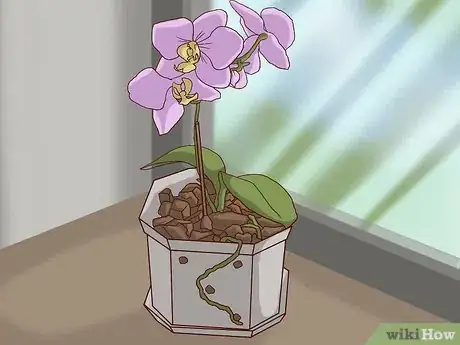
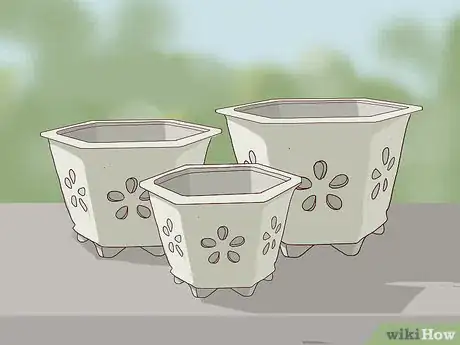
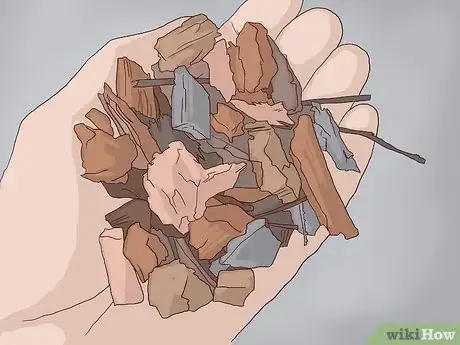
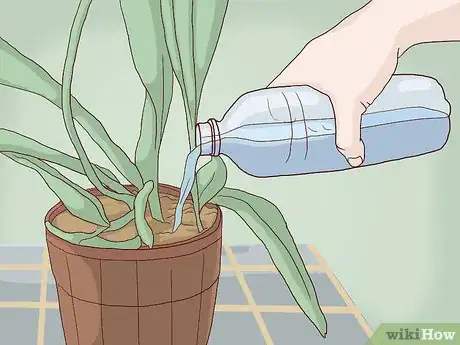
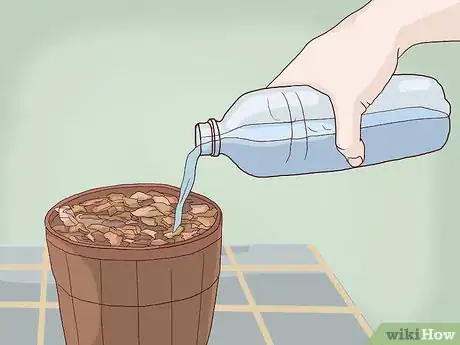
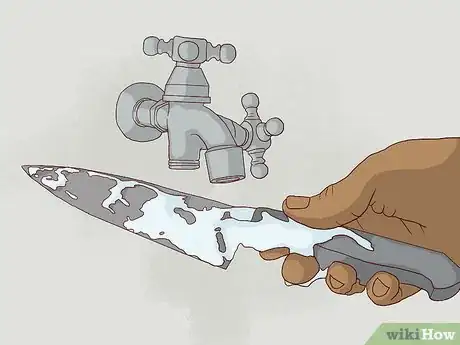
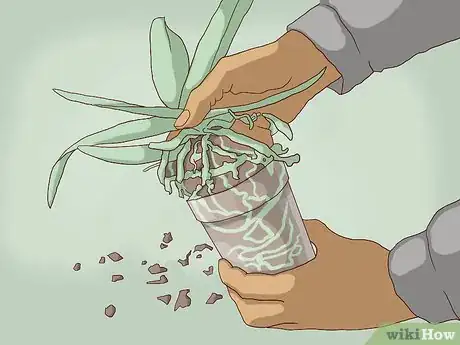
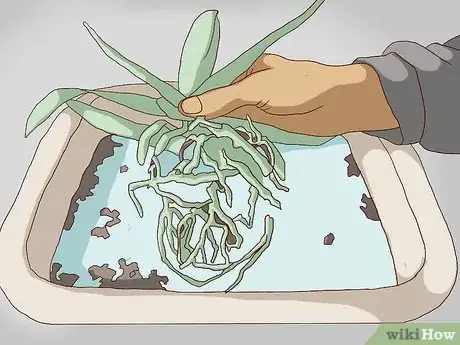
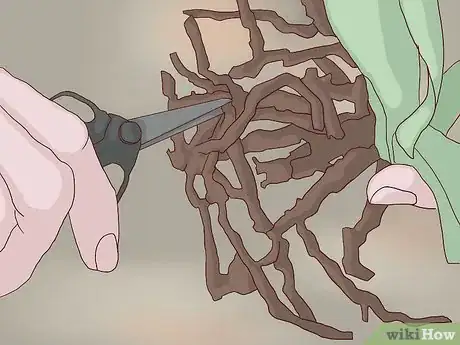
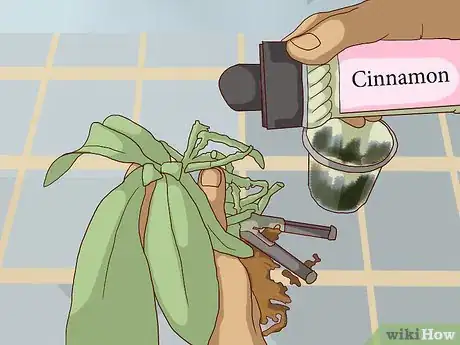
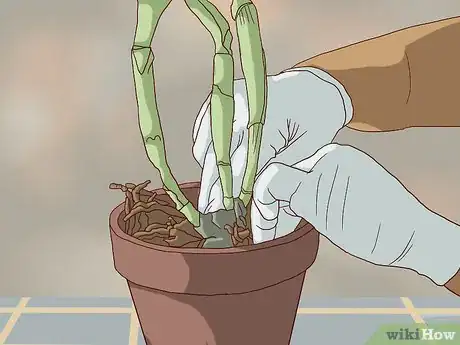
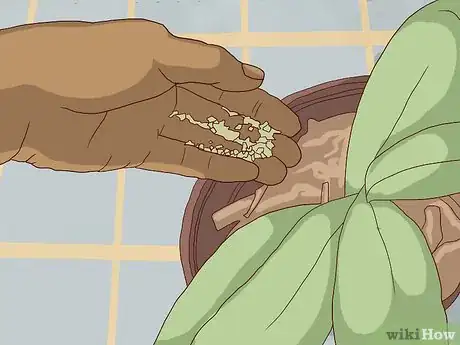
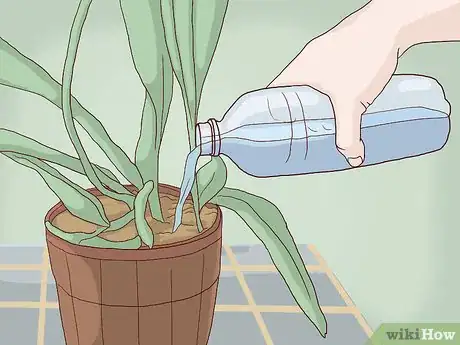

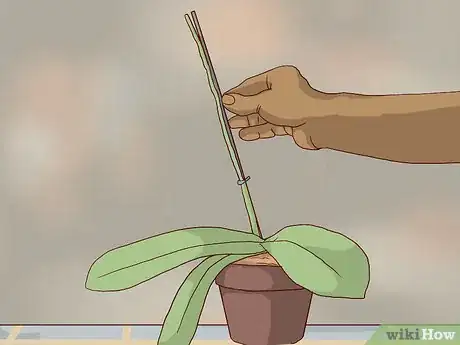
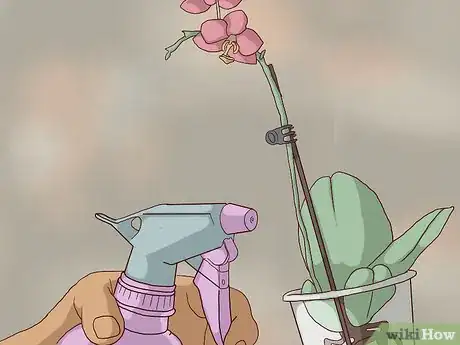
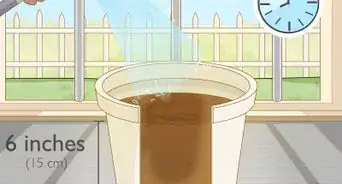

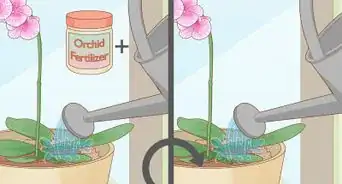

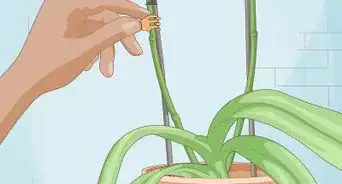
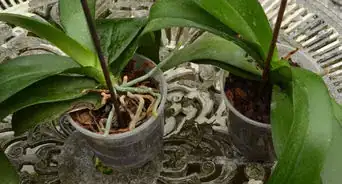
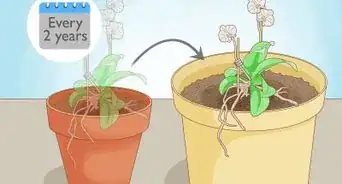



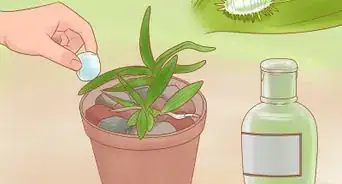
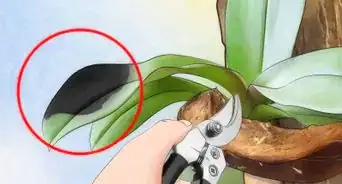
-Step-8.webp)

















































